Lasting Impressions – European Influence on African Art
PRIMITIVE - Friday, February 12, 2016By Misaki Imagawa
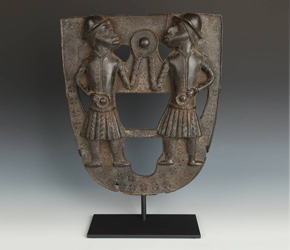 |
|
Often we hear about the influence of African art on 20th century Modernist movements; most notably, cubism. Now-famous artists such as Picasso and Matisse were two of many who were intrigued and inspired by and even collected the highly stylized and abstract art forms emerging from Africa during the 1900s; but what of the opposite? Was African art ever influenced by European contact? The answer may surprise you. As far back as the 15th century and in the hundreds of years since then, African artists have absorbed specific influences from European explorers, imbuing their art with meaning and contributing to distinct tribal styles.
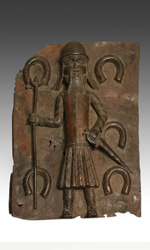 |
|
In the 200 years between the early 1400s and the 1600s Portugal was the leader in world exploration and trade. While the rest of Europe was mercilessly ravaged by the Black Plague, Portugal remained largely unharmed due to its relative geographic isolation. Prior contact with the Islamic world had also given the Portuguese greater mathematical knowledge, allowing them to build ships sturdy enough to make long and arduous voyages down and around the African continent. The Portuguese were the very first Europeans to make contact with African tribes and their subsequent trading interactions left visual legacies in various African artworks, especially in the geographic area of Central Africa.
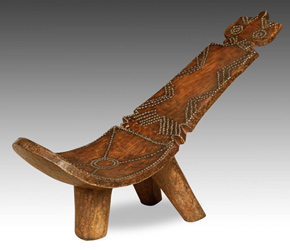 |
|
Contrary to popular belief, early European explorers did not encounter poor, uncivilized, primitive savages when they landed in Africa. The African kingdoms were as large, complex and well established as those back home, if not more so. In fact, compared to pre-industrial Europe, some were even technologically more advanced, possessing greater skills in agriculture and craft, especially bronze casting; and their cities were more hygienic than the plague-matted filth of Europe. Trade existed between Portugal and many African states as equal, respectful powers. Europeans brought in iron, copper, cloth, jewelry, glass beads, cowry shells and alcohol. In return, Africans traded textiles, spices, carved artworks, wax, gum, rubber, ivory and slaves.
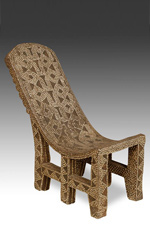 |
|
However, greater than the goods they traded was the influence of one culture upon another, especially when it came to art, functional and otherwise. For example, despite limited space on ships, ranking European officials would bring chairs or commission them in-country when they landed. Seeing this, African leaders began to associate seats with authority. Stools had an already long-standing tradition of signifying positions of high status in Africa. Many were solely meant for chiefs, nobles and elders. Gradually, African carvers began styling chairs based on European designs, decorating them with imported cowry shells, glass beads and brass tacks to further enhance their prestige.
The Kuba people of the Democratic Republic of Congo are well known for their European-influenced studded throne chairs. These curved back chairs combine elements of traditional stools and the high-back chairs of Europe. Kuba artisans then further embellished these chairs by tediously applying hundreds – if not thousands – of metal studs in ornate tribal designs. Kuba artwork is often characterized by detailed decorations that put forth a unique visual language driven by geometric design. Their studded chairs are often prime examples of this language, speaking loudly to prestige, high social status, and immense wealth and power.
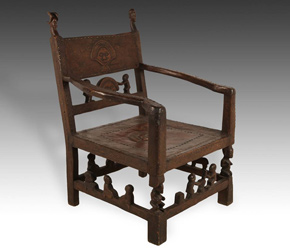 |
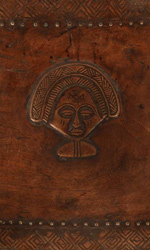 |
||
The neighboring Chokwe people, who live in the Democratic Republic of Congo and Angola, also incorporated European styling into chairs with back and arm rests heavily decorated with metal studs. However, their artistic genius truly shines in the carved figures incorporated into the rungs, legs, backrests and finials of the chairs. They represent ancestor spirits as well as subjects depicting scenes of everyday life. Though the chair form is inspired by European styles, the Chokwe transformed straightforward utilitarian furniture into unique artwork that is undoubtedly tribal, expressing the power and responsibilities of whoever sat in them; most notably, their king as a political, military and spiritual leader.
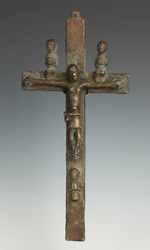 |
|
Christianity also heavily influenced Central African artworks. To this day, the majority religion in the Democratic Republic of Congo is Christianity. However, this conversion was peaceful, due in large part to the fact that many concepts of Christianity coincided with traditional local beliefs. Interpretations of words such as holy, god and spirit in the Christian doctrine were done in a way that directly translated into pre-existing notions in Congolese cosmology. For example, to certain groups the cross already held spiritual significance as a symbol of transition from the living world to the world of ancestors. The iron currencies of the Katanga people are still made in the form of crosses. Some tribes like the Tabwa embraced the new symbolism and simply combined it with their old beliefs, creating bronze crucifixes that include ancestor figures perched above Jesus. Depictions of the Virgin Mary and baby Jesus were easily assimilated to indigenous representations of pre-existing maternity figures. The introduction of Christian symbols and icons did not replace old beliefs, but instead, created additional meaning that was quickly absorbed by the people and enhanced to create new artworks singular to their respective cultures.
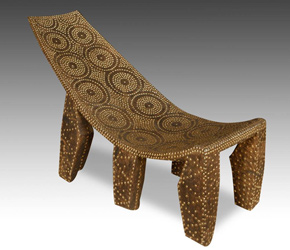 |
|
European influence on African art is reflected in the visual impact of the art itself, which retained its own unique tribal character despite the influences of European contact. Although historical documents exist about early Portuguese explorations in Africa, there are none that paint the picture from the other side, namely from the view of the African people. Instead, the stories of Africa's contact with Europeans are told orally and through “decoding” the artworks that followed. While many stories have been lost in time, they can be found deeply embedded within every detail of artwork found on the continent. Close your eyes and feel the cool brass nails of a Kuba throne chair, each stud eloquently describing the encounters between tribal leaders and European officials; collectively taking us on a journey to the past when Europeans first stepped foot on the African continent.
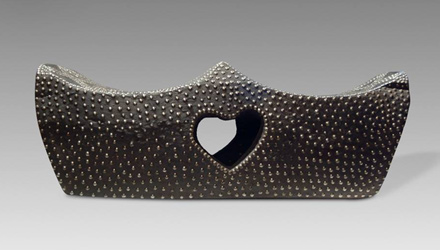 |
Download this Article: Lasting Impressions - European Influence on African Art.pdf